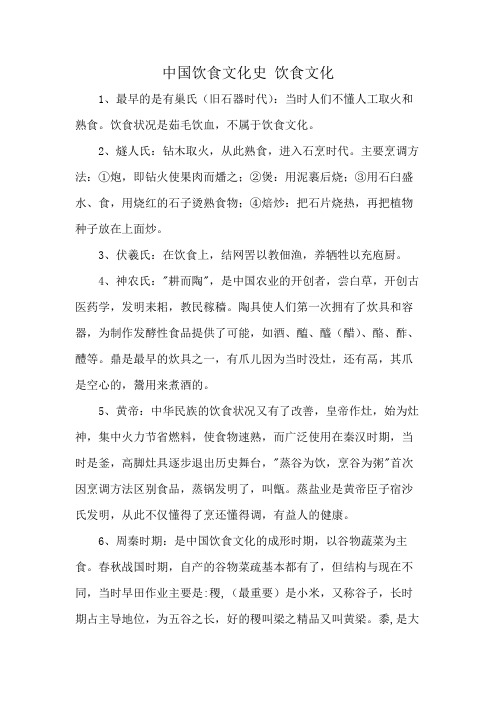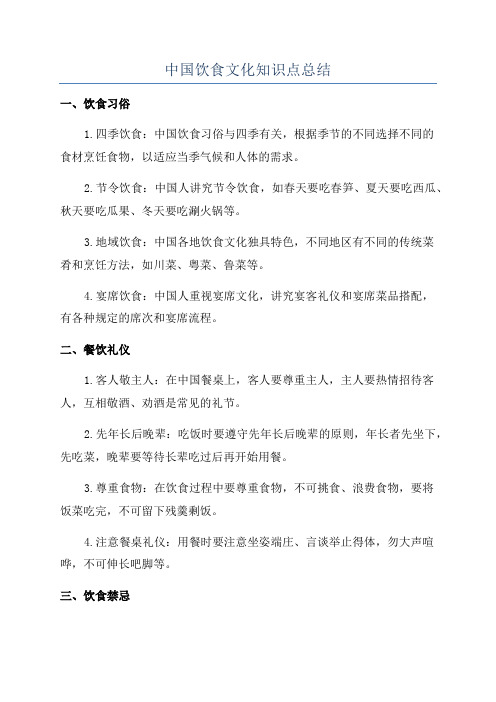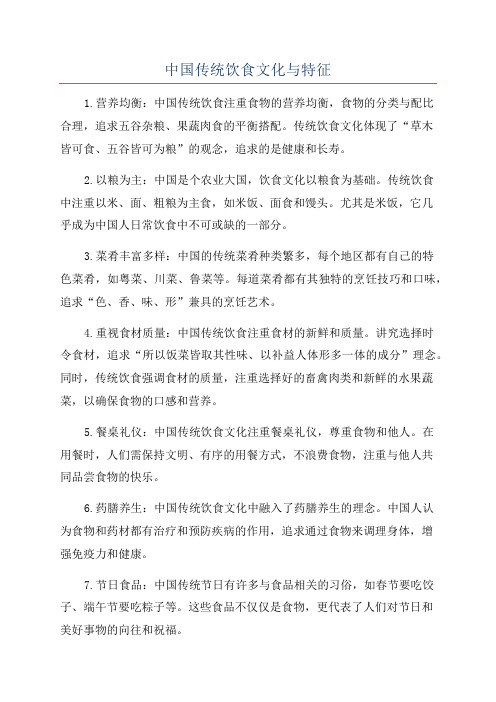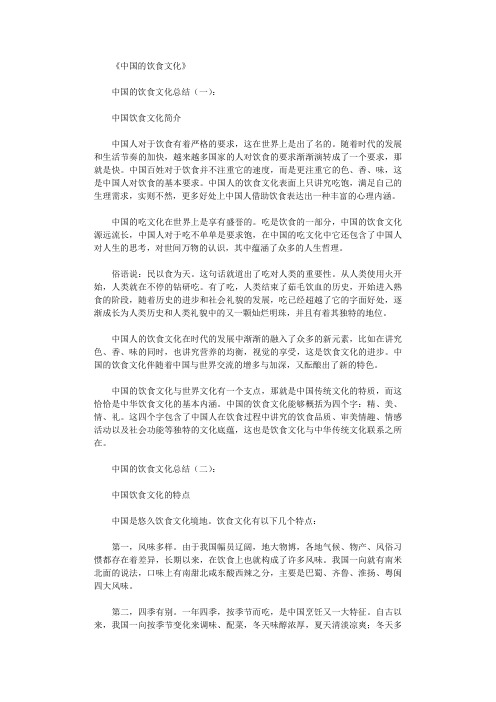中国的饮食文化
对中国饮食文化的认识

对中国饮食文化的认识
1. 历史渊源:中国的烹饪技艺可追溯至远古时代,从生食向熟食的转变标志着人类文明的进步。
早在商周时期,中国的膳食文化已有雏形,并随着历史的推进逐渐形成了丰富多样的地方菜系。
2. 地域特色与物产:由于地理环境、气候条件以及物产资源的差异,各地菜肴风味迥异,形成了八大菜系(鲁菜、川菜、粤菜、苏菜、闽菜、浙菜、湘菜、徽菜)及其它区域特色鲜明的地方美食,如赣菜等。
3. 烹饪技法与哲学思想:中国烹饪技术精湛,讲究色香味形俱全,同时融入了阴阳五行、儒家伦理、中医养生等传统哲学思想,体现出和谐共生的理念。
例如注重季节变化下的食材选择与搭配,提倡“不时不食”。
4. 饮食民俗与礼仪:饮食民俗丰富多彩,包括主食、菜肴、饮料及其食用方式,涉及饮食姿式、用具选择、餐桌礼仪等。
中国饮食文化中的宴席礼仪更是繁复而庄重,如酒令、座次排列等都有严格规定。
5. 文化交流与融合:中国饮食文化不仅在国内各地区间交流互动,也通过丝绸之路、海上丝绸之路等途径与其他国家和地区进行广泛的文化交流,使得中华美食影响深远,同时也吸收了外来饮食文化的元素。
6. 饮食与生活哲学:中国饮食中寓含着深厚的人生观和价值观,如儒家主张的“食不厌精,脍不厌细”体现对生活的热爱与尊重,道
家倡导的顺应自然则体现在季节性饮食上。
7. 食品多样性和层次消费:中国幅员辽阔,地大物博,因此在食品种类、制作工艺、餐饮服务等方面呈现出多样性。
不同的消费层次也有各自的饮食习惯和需求。
中华上下五千年的饮食文化

中华上下五千年的饮食文化中华民族拥有悠久的历史和灿烂的文化,其中饮食文化更是千姿百态、丰富多样。
自古以来,中华上下五千年的饮食文化承载着中华民族的传统和智慧,反映出社会经济发展和人民生活水平的变化。
本文将从不同的角度来探讨中华上下五千年的饮食文化。
一、古代饮食的特点古代的中华饮食文化以谷物为基础,主食主要是稻米和小麦,它们被广泛应用在各地的主食中。
此外,古代人们注重饮食的平衡,讲究五谷杂粮的搭配。
养生养生方面,中医传统理论在古代饮食文化中起到了重要的作用。
根据中医理论,食物被归类为寒、凉、温和热的性质,人们通过食物的选择与搭配来调节身体的阴阳平衡。
古代饮食还十分讲究礼仪,传统习俗使得饮食文化凝聚了社会的道德伦理。
二、不同时期的饮食变迁随着社会的发展,饮食文化也在不断变迁。
在唐宋时期,中华饮食达到了鼎盛的时期,各地方菜系和烹饪技术不断发展并繁荣起来。
明清时期,随着荷兰人、葡萄牙人等西方人的来华,新鲜蔬果、烹饪方法等开始融入中华饮食文化。
而近代以来,尤其是20世纪以后的改革开放时期,中华饮食文化受到了全球化的影响,西餐、快餐等外来饮食也逐渐在中国传统饮食中占有一席之地。
三、地域特色与民俗饮食中国饮食文化的丰富多样使得各地形成了各具特色的地方菜系。
如四川菜以其辣味和麻辣火锅而闻名,广东菜以其清淡、烹饪技巧高超而闻名。
此外,每年的传统节日也伴随着特色的饮食,如春节时的饺子、元宵和汤圆,端午节时的粽子等。
这些地域特色和民俗饮食丰富了中华饮食文化,也传承了民族的习俗与情感。
四、中华饮食文化的影响中华上下五千年的饮食文化对世界各国产生了深远的影响。
例如,传统的中国茶文化被世界所接受和喜爱,中华饮食文化的烹饪技巧也为世界各国所学习与模仿。
此外,中国的美食也成为世界各地餐桌上的一道风景,国际化的中餐馆在全球范围内得到了普及。
总之,中华上下五千年的饮食文化是中华民族深厚的历史和灿烂文化的重要组成部分。
从古至今,饮食文化随着社会的发展而不断变迁,但依然保持着自己的特色与独特性。
中国的饮食文化

一:中国的烹饪风味流派
1.地方菜系 2.宫廷菜系 3.素菜 4.药膳
中国的四大菜系:
• • • • 1.山东(鲁) 2.淮扬(杨) 3.四川(川) 4.广东(粤)
中国的八大菜系:
• “四大菜系”加上浙江(浙),安徽 (徽),湖南(湘),福建(闽)
十大菜系:
• “八大菜系”加上北京(京), 上海(沪)
代表菜及小吃:
LOGO
宫保鸡丁
夫妻肺片
鱼香肉丝
口水鸡
北川凉粉
水饺
江苏菜系简称“苏菜”。 特点:选料严谨考究,讲究鲜活,主料突出,刀工精细重于 酥烂鲜香,原汁原汤,咸甜适中,配色和谐。
八仙过海闹罗汉 凤穿牡丹
三套鸭
三丁包
糯米芝麻糕.
无锡骨
广东菜系
• 广东菜系又称粤菜,有“南烹”, “南食”之称。
中国的十二大菜系:
• “十大菜系”加上河南(豫),陕西(陕, 秦)
地方菜系
(一)山东菜系
• 山东菜系又称鲁菜,素有“北方代 表菜”之称。 • 特点:原料多样,口味鲜咸嫩脆, 清香味纯,偏重清淡,风味独特。 擅长爆,烧,炒。
代表名菜及小吃
锅塌豆腐
葱烧海参
粘豆包
糖醋鲤鱼.
四川菜系
四川菜系简称川菜,发源于古代巴国和 蜀国。主要由成都菜,重庆菜,自贡菜 和传统素菜食斋菜组成。 特点:取材广泛,调味多变,菜式多样, 味型多样,口味清鲜醇浓并重,素有 “一菜一格,百菜百味”的美誉。
龙井虾仁
福建菜系又称闽菜,又福州,厦门, 泉州等地方菜发展而成。
• 特点:原料丰富,多以海鲜为主,烹制细腻,
注重调味,色调美观,滋味清鲜。
名菜及小吃
土笋冻
中国饮食文化史 饮食文化

中国饮食文化史饮食文化1、最早的是有巢氏(旧石器时代):当时人们不懂人工取火和熟食。
饮食状况是茹毛饮血,不属于饮食文化。
2、燧人氏:钻木取火,从此熟食,进入石烹时代。
主要烹调方法:①炮,即钻火使果肉而燔之;②煲:用泥裹后烧;③用石臼盛水、食,用烧红的石子烫熟食物;④焙炒:把石片烧热,再把植物种子放在上面炒。
3、伏羲氏:在饮食上,结网罟以教佃渔,养牺牲以充庖厨。
4、神农氏:"耕而陶",是中国农业的开创者,尝白草,开创古医药学,发明耒耜,教民稼穑。
陶具使人们第一次拥有了炊具和容器,为制作发酵性食品提供了可能,如酒、醢、醯(醋)、酪、酢、醴等。
鼎是最早的炊具之一,有爪儿因为当时没灶,还有鬲,其爪是空心的,鬶用来煮酒的。
5、黄帝:中华民族的饮食状况又有了改善,皇帝作灶,始为灶神,集中火力节省燃料,使食物速熟,而广泛使用在秦汉时期,当时是釜,高脚灶具逐步退出历史舞台,"蒸谷为饮,烹谷为粥"首次因烹调方法区别食品,蒸锅发明了,叫甑。
蒸盐业是黄帝臣子宿沙氏发明,从此不仅懂得了烹还懂得调,有益人的健康。
6、周秦时期:是中国饮食文化的成形时期,以谷物蔬菜为主食。
春秋战国时期,自产的谷物菜疏基本都有了,但结构与现在不同,当时早田作业主要是:稷,(最重要)是小米,又称谷子,长时期占主导地位,为五谷之长,好的稷叫梁之精品又叫黄梁。
黍,是大黄粘米仅次于稷,又称粟,是脱粒的黍。
麦,大麦。
菽,是豆类,当时主要是黄豆,黑豆。
麻,即麻子。
菽和麻都是百姓穷人吃的,麻又叫苴。
南方还有稻,古代稻是糯米,普通稻叫粳秫,周以后中原才开始引种稻子,属细粮,较珍贵。
菰米,是一种水生植物茭白的种子,黑色,叫雕胡饭,特别香滑,和碎瓷片一起放在皮袋里揉来脱粒。
7、汉代:中国饮食文化的丰富时期,归功于汉代中西(西域)饮食文化的交流,引进石榴、芝麻、葡萄、胡桃(即核桃)、西瓜、甜瓜、黄瓜、菠菜、胡萝卜、茴香、芹菜、胡豆、扁豆、苜蓿(主要用于马粮),莴笋、大葱、大蒜,还传入一些烹调方法,如炸油饼,胡饼即芝麻烧饼也叫炉桡。
中国饮食文化知识点总结

中国饮食文化知识点总结一、饮食习俗1.四季饮食:中国饮食习俗与四季有关,根据季节的不同选择不同的食材烹饪食物,以适应当季气候和人体的需求。
2.节令饮食:中国人讲究节令饮食,如春天要吃春笋、夏天要吃西瓜、秋天要吃瓜果、冬天要吃涮火锅等。
3.地域饮食:中国各地饮食文化独具特色,不同地区有不同的传统菜肴和烹饪方法,如川菜、粤菜、鲁菜等。
4.宴席饮食:中国人重视宴席文化,讲究宴客礼仪和宴席菜品搭配,有各种规定的席次和宴席流程。
二、餐饮礼仪1.客人敬主人:在中国餐桌上,客人要尊重主人,主人要热情招待客人,互相敬酒、劝酒是常见的礼节。
2.先年长后晚辈:吃饭时要遵守先年长后晚辈的原则,年长者先坐下,先吃菜,晚辈要等待长辈吃过后再开始用餐。
3.尊重食物:在饮食过程中要尊重食物,不可挑食、浪费食物,要将饭菜吃完,不可留下残羹剩饭。
4.注意餐桌礼仪:用餐时要注意坐姿端庄、言谈举止得体,勿大声喧哗,不可伸长吧脚等。
三、饮食禁忌1.偏食忌辛辣:中国饮食禁忌中有禁忌偏食,忌过于嗜辛辣刺激的食物,以免伤害脾胃。
2.不宜过量:中国人饮食注重平衡,不宜过量,大鱼大肉、油腻辛辣的食物要适量食用。
3.忌生吃生冷:中国饮食文化忌生吃生冷食物,认为这样容易伤害脾胃,影响身体健康。
4.忌吃动物的头部:中国有吃动物头部的忌讳,认为头部为先天之气所在,忌食动物头部。
四、餐具礼节1.餐具摆放:中国人讲究餐具摆放的规矩,如筷子要放在右侧,碗要正对着主人等。
2.用筷子注意事项:用筷子时要注意避免发出刺耳的咬合声音,不可竖插在饭中,不可将筷子交叉放在碗上等。
3.点心吃法:中国的点心吃法也有许多礼仪,如不可一口吃完,要小口尝,分次享用,不可大口吞咽等。
总的来说,中国饮食文化丰富多彩,体现了中华民族的传统礼仪和人文精神。
在现代社会,随着生活水平的提高和文化交流的加深,中国饮食文化也在不断创新与发展,吸收外来文化的精华,塑造出更加多元化的饮食文化。
同时,传统的饮食文化依然保留着其珍贵的传统和魅力,成为人们日常生活中不可或缺的重要组成部分。
中国传统饮食文化与特征

中国传统饮食文化与特征1.营养均衡:中国传统饮食注重食物的营养均衡,食物的分类与配比合理,追求五谷杂粮、果蔬肉食的平衡搭配。
传统饮食文化体现了“草木皆可食、五谷皆可为粮”的观念,追求的是健康和长寿。
2.以粮为主:中国是个农业大国,饮食文化以粮食为基础。
传统饮食中注重以米、面、粗粮为主食,如米饭、面食和馒头。
尤其是米饭,它几乎成为中国人日常饮食中不可或缺的一部分。
3.菜肴丰富多样:中国的传统菜肴种类繁多,每个地区都有自己的特色菜肴,如粤菜、川菜、鲁菜等。
每道菜肴都有其独特的烹饪技巧和口味,追求“色、香、味、形”兼具的烹饪艺术。
4.重视食材质量:中国传统饮食注重食材的新鲜和质量。
讲究选择时令食材,追求“所以饭菜皆取其性味、以补益人体形多一体的成分”理念。
同时,传统饮食强调食材的质量,注重选择好的畜禽肉类和新鲜的水果蔬菜,以确保食物的口感和营养。
5.餐桌礼仪:中国传统饮食文化注重餐桌礼仪,尊重食物和他人。
在用餐时,人们需保持文明、有序的用餐方式,不浪费食物,注重与他人共同品尝食物的快乐。
6.药膳养生:中国传统饮食文化中融入了药膳养生的理念。
中国人认为食物和药材都有治疗和预防疾病的作用,追求通过食物来调理身体,增强免疫力和健康。
7.节日食品:中国传统节日有许多与食品相关的习俗,如春节要吃饺子、端午节要吃粽子等。
这些食品不仅仅是食物,更代表了人们对节日和美好事物的向往和祝福。
总的来说,中国传统饮食文化注重食物的营养均衡、饮食方式的文明礼仪、注重食材的质量和时令、讲究烹饪技巧和口感以及融入了药膳养生的理念。
中国人对食物的重视不仅仅是为了满足口腹之欲,更是为了身体健康和心灵的满足。
这些特征使得中国传统饮食文化成为了世界上受人赞赏的一种饮食文化。
中国古代饮食风俗

中国古代饮食风俗一、饮食文化中国饮食文化源远流长,有着悠久的历史和深厚的底蕴。
在古代,人们注重饮食的色、香、味、形、器,认为饮食不仅仅是满足口腹之欲,更是一种文化修养的体现。
因此,在古代的饮食风俗中,也体现了人们对于饮食文化的重视和追求。
二、节令食俗节令食俗是中国古代饮食风俗的重要组成部分。
在不同的节令时期,人们会食用不同的食物来祈求平安、吉祥、丰收等。
例如,春节时吃饺子、年糕,中秋节时吃月饼,端午节时吃粽子等。
这些节令食俗不仅丰富了人们的饮食生活,也传承了中华民族的文化传统。
三、饮茶风俗中国是茶的故乡,茶文化是中国文化的重要组成部分。
在古代,饮茶风俗盛行,人们将茶视为清雅、高洁的饮品,常常以茶会友、以茶祭祀、以茶作诗等。
茶在人们的生活中扮演着重要的角色,也成为了人们交流思想、增进友谊的重要媒介。
四、少数民族食俗中国是一个多民族的国家,各民族在饮食风俗上都有着自己独特的特点。
例如,回族的油香、苗族的酸汤鱼、壮族的五色饭等,都展现了不同民族独特的饮食文化和风味。
这些少数民族食俗不仅丰富了中国的饮食文化,也展示了中华民族的多元性和包容性。
五、地方食俗中国地域辽阔,各地的气候、物产、风俗习惯等都有所不同,因此形成了各具特色的地方食俗。
例如,川菜的麻辣、粤菜的清淡、湘菜的香辣等,都体现了各地独特的口味和烹饪技巧。
这些地方食俗不仅满足了人们的口腹之欲,也传承了各地的文化传统和特色。
六、祭祀食俗在中国古代,祭祀是人们生活中的重要组成部分。
在祭祀活动中,食物是必不可少的供品。
不同的祭祀对象需要不同的食物,如猪头、牛头、羊头等。
此外,祭祀食俗还规定了在祭祀活动中不能食用某些食物,以示尊重和虔诚。
这些祭祀食俗体现了人们对于神灵的信仰和敬畏,也传承了中国古代的文化传统。
七、医药食俗在中国古代,医药食俗是一种独特的饮食风俗。
人们认为食物具有药用价值,可以治疗疾病和保健身体。
例如,红枣可以补血、枸杞可以补肾、生姜可以驱寒等。
中国的饮食文化

中国的饮食文化导言中国是一个拥有悠久历史和丰富传统的国家,其饮食文化也是独具特色的。
无论是饮食习惯、烹饪技艺还是饮食哲学,中国的饮食文化都有着浓厚的魅力。
本文将从中国的饮食特点、餐饮礼仪以及中国菜系等方面展开论述。
1. 饮食特点中国的饮食特点是多样而丰富的,不同地区有不同的饮食习俗和烹饪风味。
中国的饮食文化注重食物的营养价值和口味的搭配,讲究色、香、味、形、器的五个要素。
以下是中国饮食文化的几个显著特点:1.1 四大菜系中国有四大菜系,即川菜、粤菜、湘菜和鲁菜。
四大菜系代表了中国不同地区的烹饪风格和口味特点。
川菜以其麻辣味闻名,粤菜注重原料的新鲜和味道的鲜美,湘菜以酸辣味为主,鲁菜是中国最早、历史最长的一种烹饪风格,以浓、炖、煮为特点。
1.2 中餐配菜中国菜的配菜常常伴随主菜一起上桌,相互搭配以增加食物的口感和味道。
中国菜的配菜有时也像主菜一样讲究刀工和造型,以吸引食客的注意力。
常见的配菜有凉拌菜、炒菜、炖菜等,既满足了味蕾的需求,也展现了烹饪师傅的创意和精湛的技巧。
1.3 营养均衡中国的饮食文化注重食物的营养搭配,追求“五谷杂粮”、“荤素搭配”的原则,注重平衡蛋白质、碳水化合物、脂肪、维生素等的摄入。
中国人重视荤素搭配,将蔬菜与草食动物的肉类搭配,以保证全面的营养摄入。
2. 餐饮礼仪中国餐饮礼仪是中国的传统文化的重要组成部分,注重尊重和和谐。
以下是中国餐饮礼仪的几个方面:2.1 客礼主义中国的餐饮礼仪强调尊重客人,常常有主人和客人分座的习俗。
主人通常会亲自招待客人并为客人倒酒、夹食物等,体现了中国尊重和关心客人的礼仪。
2.2 用餐顺序中国人有特定的用餐顺序,常按照“汤、荤、素、主食”顺序就餐。
中国人重视均衡饮食,注重食物的热量和营养的搭配,因此用餐顺序也体现了对健康饮食的追求。
2.3 饮食文化节日中国有许多与饮食相关的文化节日,例如春节、中秋节、清明节等。
这些节日在中国人的生活中占据着重要的地位,人们会举办家庭聚餐、朋友聚会等活动,共同品尝传统的食物,并通过饮食来表达亲情和友情。
《中国饮食文化》课件

中国是一个多民族的国家,各民族在长期的历史发展过程中形成了独特的饮食文化。例如 ,藏族以糌粑、酥油茶为主要食品,回族以清真食品为主,蒙古族以奶制品和牛羊肉为主 食。
02
中国传统烹饪技巧
炒菜
炒菜是中国传统烹饪技巧之一,通过高温快速翻炒食材,使食材快速熟透并保持鲜 嫩口感。
炒菜时需要注意火候和油温的控制,以及翻炒的力度和速度,以保持食材的完整和 鲜嫩。
食品安全
现代营养学还强调食品安全的重要性,避 免食物中毒和其他食品安全问题对健康的 影响。
中国饮食的未来发展
传统与现代的融合
未来的中国饮食将更加注重传统与现代的 融合,将传统食材与现代烹饪技术相结合
,创造出更加美味和健康的菜肴。
A 健康饮食趋势
随着人们对健康的关注度不断提高 ,低糖、低脂、高纤维等健康食品
蔬菜与水果
总结词
蔬菜与水果在中国饮食文化中占据重要地位,提供了丰富的维生素、矿物质和膳食纤维。
详细描述
中国地域辽阔,气候多样,因此蔬菜与水果种类繁多。常见的蔬菜有青菜、茄子、黄瓜、豆角等,水 果则包括苹果、梨、桃、柑橘等。此外,还有一些特色蔬菜和水果,如竹笋、菌菇、杨梅等。
肉类与海鲜
总结词
肉类与海鲜是中国饮食文化中的重要蛋白质来源,口感鲜美,营养丰富。
地域差异
南北差异
中国地域辽阔,气候和地形地貌多样,因此各地饮食文化存在显著的差异。南方气候湿润 ,多水产品,因此南方菜以清淡、鲜美为主;而北方气候干燥,多畜牧,因此北方菜以油 腻、咸香为主。
东西差异
中国的东部、中部和西部地区由于地理环境、气候条件和历史背景的差异,形成了各具特 色的饮食文化。例如,东部沿海地区以海鲜为主要食材,而西部地区则以牛羊肉为主要食 材。
中餐文化概述

中餐文化,即中国饮食文化,是指中国风味的餐食菜肴以及与之相关的饮食习俗、礼仪、精神等。
中餐文化源远流长,有着几千年的历史,受到各地环境、气候、物产、风俗以及饮食习惯的影响,形成了各种具有地方风味特色的流派。
其中,粤菜、川菜、鲁菜、淮扬菜、浙菜、闽菜、湘菜、徽菜被广泛认为是八大菜系。
1. 菜系:中餐有着丰富多样的菜系,每个菜系都有其独特的风味和烹饪技法。
如粤菜讲究清而不淡、鲜而不俗;川菜以麻辣、鱼香、怪味等味型著称;鲁菜讲究调味纯正,具有鲜、嫩、香、脆的特色;淮扬菜追求本味,清鲜平和;浙菜菜式小巧玲珑,清俊逸秀;闽菜口味上以爽、脆、鲜、嫩为特色;湘菜讲究色、香、味、型的搭配;徽菜以烹饪山珍野味、河鲜家禽见长。
2. 菜品:中餐的菜品丰富多样,包括各种肉类、海鲜、蔬菜、豆腐等,以及各种烹调方式,如炒、炖、烤、蒸、煮、炸、拌、熘等。
在味道上,中餐讲究色、香、味、型的搭配,使菜品色香味俱佳。
3. 饮食礼仪:在讲究礼仪的中国,饮食礼仪自然成为饮食文化的一个重要部分。
中餐的饮宴礼仪号称始于周公,千百年的演进,形成了一套饮食进餐礼仪,包括餐具的使用、上菜顺序、敬酒等。
4. 饮食精神:中餐文化强调“民以食为天”,在追求美味的同时,也注重饮食的养生保健作用。
中餐讲究阴阳调和、五味平衡,以五谷养六脏,强调食物的搭配和烹饪技法。
综上所述,中餐文化是一个历史悠久、内涵丰富、独具特色的文化体系,包括各种菜系、丰富的菜品、讲究的饮食礼仪和饮食精神。
中国饮食文化介绍

中国饮食文化介绍一、独特的烹饪方法中国烹饪技术源远流长,有很多独特的烹饪方法。
中国人注重食材的选择和制作技巧,追求菜品的鲜、嫩、烂、香和色、香、味、形的完美结合。
中国独有的烹饪技巧包括烹炒、烹炸、烹煮、蒸烧、烤炙等,能充分保留食物的原汁原味和营养成分。
二、丰富多样的饮食习惯中国地域广阔,各地的饮食习惯各不相同。
北方人以面食为主,南方人以米饭为主,西南地区以黄米饭为主,东北人以大米饭为主,东北人以小米饭为主。
此外,各地食物的制作方法也有所不同。
比如说,川菜以麻辣为特色,粤菜注重原汁原味,湘菜以辣为主,淮扬菜讲究色香味俱佳,徽菜以山珍海味为特色,闽菜以清淡为主。
三、饮食节庆的传统中国有许多与饮食相关的传统节庆活动,如春节、元宵节、端午节、中秋节等。
在这些节日里,人们会准备丰盛的饭菜款待来访的亲友,以表达对他们的友好和祝福。
同时,在节日里,还有吃汤圆、吃粽子、吃月饼等特色食物的习俗。
这些传统节庆活动不仅丰富了人们的生活,也体现了人们对美食的热爱和传统文化的传承。
四、饮食文化的精髓和内涵中国饮食文化的精髓和内涵体现在对饮食的审美追求、礼仪规范以及营养健康的均衡概念。
中国人认为,饮食不仅是一种生理需要,更是一种审美享受和社交活动的载体。
饮食过程中的礼仪规范非常重要,如入席顺序、筷子使用方式等要求。
而且,中国人注重饮食的营养搭配,追求饮食的协调和谐。
例如,中国人认为五谷为养,谷物、蔬菜、肉类等并重才能全面补充人体所需各种营养物质。
五、影响世界的中国美食中国的美食以其独特风味和制作工艺,逐渐影响着世界各地的餐饮文化。
中国的燕窝、鱼翅、福建的闽菜、广东的粤菜等都是享誉世界的特色美食。
同时,中国的香菇、竹笋、酱油、豆腐等食材也广泛应用于世界各地的菜肴制作中。
总结起来,中国饮食文化以其独特的烹饪方法、丰富多样的饮食习惯、重视节庆传统、体现人文精神和对美食的品味追求,成为中华民族传统文化的重要组成部分。
这一文化传统不仅丰富了中国的餐桌,也影响着世界各地的饮食文化。
中国饮食文化特点

中国饮食文化特点一、传统的饮食观念中国饮食文化重视均衡和谐,强调五谷为基础,饮食宜杂粮为主,倡导营养均衡,追求以粗糙、自然、原始的食材为主,体现了天人合一的哲学思想。
此外,中国人还注重饮食的质量而非数量,强调“营养固本”,即食物的药性和营养价值与身体特点相匹配,避免过食伤身。
二、烹饪技艺独特中国饮食文化以其博大精深的烹饪技艺而著名。
中国厨师讲究火候、调味和造型三大要素,善于运用刀工、火功以及调料的配合,使得每一道菜品都具有独特的色、香、味、形。
中国八大菜系(鲁、川、粤、苏、闽、湘、浙、徽)分别代表了不同的地域文化和烹饪技法,使得中国餐饮业世界闻名。
三、食材丰富多样中国幅员辽阔,地形气候多样,因此食材种类繁多。
五谷杂粮、肉类、水产品、果蔬丰富多样,因地制宜的生产方式使中国菜肴的色香味俱佳。
同时,中国饮食文化还牢固扎根于应季应时的观念,以及尊重自然原材料的选择,例如春季食用春笋、夏季食用苦瓜等。
四、餐桌礼仪中国餐桌礼仪历史悠久,注重礼仪和谦逊。
从用餐准备到用餐结束,中国人注重端庄、热情和尊重。
例如,中国人会提前对客人进行招待、关心和照顾,座次的安排也十分重要,通常以长者和贵宾为主。
在饮食过程中,中国人还强调“共享美食”,把食物当做饭桌上的“信物”,用以表示对友好的尊重和感谢。
五、食用方式独特中国有许多独特的食用方式,如使用筷子取食、将饭菜放在共用的中央盘子上和共同切菜,均体现了中国人强调协作和团结的价值观。
此外,中国人对食物的烹饪方式也非常独特,如清蒸、红烧、涮、炖等,每种烹饪方式都有不同的目的和特点,使得中国菜肴的口感丰富多样。
六、传统节日和饮食中国传统节日与饮食文化密切相关,每个节日都有特定的食物和烹饪方式。
例如,春节期间人们喜欢吃饺子和年糕,端午节期间喜欢吃粽子,中秋节期间人们喜欢吃月饼等。
这些传统节日食品不仅满足人们对美食的需求,也承载着祝福和祭祀的寓意。
总而言之,中国饮食文化具有博大精深的特点,强调均衡、谐和和礼仪。
中国饮食文化有哪些

中国饮食文化有哪些中国饮食文化是一个庞大而多样的体系,它深受中国传统文化、地理环境、民族习惯、宗教信仰等因素的影响。
以下是一些中国饮食文化的特点:1.素食为主:中国的饮食文化以素食为主,注重蔬菜、水果、豆类等食材的烹饪。
这与中国的传统文化中对自然和和谐的追求有关。
2.重视健康和进补:中国饮食文化强调健康和进补,注重食物的搭配和营养的平衡。
在烹饪过程中,各种食材的搭配和烹制方法都体现了对健康的关注。
3.“色、香、味”俱全:中国饮食文化追求菜肴的色彩搭配要明媚如画,同时要求菜肴具有香味和美味。
这也是中国烹饪技艺的重要组成部分。
4.五味调:中国饮食文化强调五味调,即酸、甜、苦、辣、咸五种味道的平衡和协调。
在烹饪过程中,五味调不仅使菜肴口感丰富,也体现了中国传统文化中对和谐和平衡的追求。
5.奇正互变的烹调法:中国饮食文化中的烹调法多样,包括炒、炖、煮、炸、蒸等多种方式。
这些烹调方法不仅使菜肴口感各异,也体现了中国传统文化中对变化和适应的重视。
6.畅神怡情的美食观:中国饮食文化不仅关注食物的口感和营养,还注重食物对人的情感和心理的影响。
在享受美食的同时,人们也追求心灵的愉悦和满足。
7.地域特色:中国的饮食文化具有强烈的地域特色,不同地区有不同的饮食习惯和特色菜肴。
这些地域特色与各地的地理环境、气候条件、民族习惯等因素密切相关。
8.民族特色:中国的饮食文化也具有强烈的民族特色。
不同民族有不同的饮食习惯和特色菜肴,这些民族特色与各民族的历史文化、宗教信仰、社会习俗等因素有关。
9.文化交流:中国的饮食文化不仅在国内有广泛的影响,还通过华侨、留学生等渠道传播到海外。
在海外,中国的饮食文化与其他文化交流和融合,形成了具有国际特色的中国餐饮文化。
中国饮食文化的主要内容

中国饮食文化的主要内容饮食文化是一个国家的文化传统之一,它反映了人们对食物的态度、饮食习惯、烹饪技艺和饮食礼仪。
中国饮食文化源远流长,丰富多样,被誉为世界四大美食文化之一。
它包含着丰富的内容,下面将从中国饮食的历史渊源、典型菜系、烹饪技艺以及饮食礼仪等方面进行探讨。
一、历史渊源中国饮食文化的历史可以追溯到几千年前的古代。
在中国古代,饮食一直被视为重要的社交活动,有着丰富的象征意义和文化内涵。
从古代的宫廷御宴到民间的庆典盛宴,食物的种类、颜色、口味、烹饪方法都受到了深刻的影响。
二、典型菜系中国饮食文化以其独特的菜系而闻名于世。
八大菜系被公认为中国最具代表性的菜系,它们分别是川菜、粤菜、鲁菜、苏菜、闽菜、浙菜、湘菜和徽菜。
每个菜系都有其独特的口味、风格和烹饪方法,反映了不同地区的地域特色和人们对美食的不同追求。
三、烹饪技艺中国烹饪技艺以其精湛的刀工技巧和独特的烹调方法而闻名。
刀工是中国烹饪技艺的重要组成部分,巧妙的刀工可以使食物更加美观,提升口感和食欲。
同时,中国烹饪注重火候的掌握,讲究时间、温度和火力的平衡,以保持食材的原汁原味和养分。
炒、蒸、煮、炖等多种烹调方法的运用使中国菜肴有着丰富的口味层次和独特的风味。
四、饮食礼仪中国饮食文化注重饮食礼仪的规范和传承。
从古代的宴会制度到现代的饭局规矩,饮食礼仪一直被认为是展示个人教养和社交能力的一种方式。
在中国传统文化中,餐桌上的座次、用餐顺序、菜肴摆放等方面都有着严格的规范和礼节。
例如,尊长先食、客人先食主人下筷等都是中国饮食礼仪中的常见规矩。
中国饮食文化是中华民族的瑰宝,它深深影响着人们的生活方式和社会交往。
从传统的饮食习惯到现代的美食文化,中国饮食一直在不断演变和发展。
中国人崇尚天人合一的饮食观念,注重食物的天然和健康,强调饮食的和谐和平衡。
今天,中国的饮食文化正逐渐受到世界的认可和喜爱。
中华美食正通过各种传媒渠道和人员交流传遍全球,丰富了人们的餐桌和生活。
中国传统饮食中国传统文化ppt课件

▲耒耜
3 一、中国传统饮食的发展
(二)夏、商、周时期的饮食文化
到了周代,石磨的出现,促成了谷物加工方法上一次质的飞跃。 在烹饪方法上,夏商两代的烹饪方法都很稀少。到了周代,随着生产力的快速发展,烹 饪方法才逐渐多样化,出现了煮、蒸、炒、烤、炙、炸等多种方法。 周代已对饭(主食)、菜(副食)和汤饮进行了明显的区分,这标志着我国传统烹饪方 法的初步定型。
18 一、茶的起源和品种
义
狭义 文化
传文 统化
3.明清时期 明代,太祖朱元璋下诏废团茶,兴叶茶。此 后贡茶由团饼茶改为芽茶,这就促进了炒青散茶的发 展。明人罗廪所著的《茶解》对茶树栽培及绿茶炒制技艺 进行了详细的描述。1610年开始将茶叶销往欧洲各国,清 代,销往荷兰和英国。1903年以前,中国茶叶在世界茶叶 市场仍占据重要地位,此后则江河日下。
6 一、中国传统饮食的发展
(五)元、明、清时期的饮食文化
元代,涮羊肉、烤全羊、月饼、烤鸭
明代,马铃薯、甘薯、肉食以人工蓄养的畜禽为主要来源。
清朝,浙、闽、湘、徽等地方菜进一步发展,并自成派系,加上传统的“四大菜系”,逐渐
形成“八大菜系”之说。后来,又增加京、沪等地方菜,形成了“十大菜系”。
传文
现代满汉全席
明清时期,酒已成为人们生活中不可或缺的饮 品,每逢佳节,人们多会设宴饮酒。不同的节日所 饮的酒也有所不同。
明清时期,饮酒特别讲究“陈”,所谓“陈年 佳酿”就是指上了年份的好酒。
▲清代酒令
27 二、中国的酒文化
(一)酒与经济
我国自古以来就是一个农业大国,农业一直是国民经济的命脉,因此国家的一切政 治、经济活动都是以农业发展为根本立足点的。而我国的酒,绝大部分都是用粮食酿 造的,因而酒的生产也依赖于粮食生产,成为了农业经济的一部分,粮食生产的丰歉 往往直接影响着酒业的兴衰。
中国的饮食文化(总结5篇)

《中国的饮食文化》中国的饮食文化总结(一):中国饮食文化简介中国人对于饮食有着严格的要求,这在世界上是出了名的。
随着时代的发展和生活节奏的加快,越来越多国家的人对饮食的要求渐渐演转成了一个要求,那就是快。
中国百姓对于饮食并不注重它的速度,而是更注重它的色、香、味,这是中国人对饮食的基本要求。
中国人的饮食文化表面上只讲究吃饱,满足自己的生理需求,实则不然,更多好处上中国人借助饮食表达出一种丰富的心理内涵。
中国的吃文化在世界上是享有盛誉的。
吃是饮食的一部分,中国的饮食文化源远流长,中国人对于吃不单单是要求饱,在中国的吃文化中它还包含了中国人对人生的思考,对世间万物的认识,其中蕴涵了众多的人生哲理。
俗语说:民以食为天。
这句话就道出了吃对人类的重要性。
从人类使用火开始,人类就在不停的钻研吃。
有了吃,人类结束了茹毛饮血的历史,开始进入熟食的阶段,随着历史的进步和社会礼貌的发展,吃已经超越了它的字面好处,逐渐成长为人类历史和人类礼貌中的又一颗灿烂明珠,并且有着其独特的地位。
中国人的饮食文化在时代的发展中渐渐的融入了众多的新元素,比如在讲究色、香、味的同时,也讲究营养的均衡,视觉的享受,这是饮食文化的进步。
中国的饮食文化伴随着中国与世界交流的增多与加深,又酝酿出了新的特色。
中国的饮食文化与世界文化有一个支点,那就是中国传统文化的特质,而这恰恰是中华饮食文化的基本内涵。
中国的饮食文化能够概括为四个字:精、美、情、礼。
这四个字包含了中国人在饮食过程中讲究的饮食品质、审美情趣、情感活动以及社会功能等独特的文化底蕴,这也是饮食文化与中华传统文化联系之所在。
中国的饮食文化总结(二):中国饮食文化的特点中国是悠久饮食文化境地。
饮食文化有以下几个特点:第一,风味多样。
由于我国幅员辽阔,地大物博,各地气候、物产、风俗习惯都存在着差异,长期以来,在饮食上也就构成了许多风味。
我国一向就有南米北面的说法,口味上有南甜北咸东酸西辣之分,主要是巴蜀、齐鲁、淮扬、粤闽四大风味。
中国饮食文化特征

中国饮食文化特征1.尊重食材:中国饮食文化强调尊重食材,追求天然、新鲜、健康的食材。
中国人善于利用各种食材,尤其是植物食物,注重品尝食材的原汁原味。
例如,烹调方法中,清蒸、炖煮、凉拌等都是保持食材本身鲜美味道的常见方法。
2.平衡营养:中国饮食文化十分注重营养的平衡,追求五谷杂粮、青菜红薯等不同食材的搭配。
中国饮食文化倡导“荤素搭配,粗细搭配”,既保证了饮食的口感和美味,又能够使人体吸收各种必需的营养物质。
3.色香味俱佳:中国饮食文化重视食物的色香味同时出现,追求色彩鲜明、香气扑鼻、具有特殊风味的菜肴。
中国烹调注重火候和调味品的运用,以增强菜肴的口感和口味,将菜肴变得更加可口诱人。
4.礼节文化:中国饮食文化强调餐桌上的礼仪和风俗,例如,尊老爱幼、尊重客人、注重孝道等。
中国人认为饮食是交流感情和凝聚亲情的重要方式,因此在饮食过程中注重团聚和互动,讲究和谐愉悦的氛围。
5.地域丰富:中国地域辽阔,每个地区都有独特的饮食特色。
中国饮食文化中有广东菜、川菜、粤菜、鲁菜等不同的菜系,每个菜系都有其独特的烹调方法和风味。
这种地域特色使中国的饮食文化更加多元化和丰富。
6.传统食物:中国饮食文化中有许多传统的食物,如汤圆、年糕、粽子、饺子等,这些食物与中国传统节日和民俗有着密切的关系,给人以浓厚的文化氛围。
这些传统食物承载了丰富的象征意义,如团圆、祝福、纪念等。
7.饮食节令:中国饮食文化强调与季节性的食品相结合,注重适应自然的变化。
中国人把吃当作一种居住在极具季节性的国家中的必然选择,因而它的饮食文化也因应而生活出了一套共识和规范。
每逢节气,都有相应的食材和菜肴,如春天的草头粉、夏天的凉菜、秋天的石榴,冬天的火锅等。
中国的饮食文化

中国的饮食文化中国的饮食文化源远流长,历史悠久丰富多彩。
中国人民讲究“食疗”、“养生”和“荤素搭配”,早在古代就有了“荤素调和、粗细相济”的饮食观念。
下面将从食材、烹饪方法、饮食习惯等方面来介绍中国的饮食文化。
一、食材中国的饮食文化丰富多样,各地风味各具特色。
北方以小麦为主食,有烤麸、馒头等传统面食;而南方则以稻米为主食,有米饭、粽子等传统美食。
此外,鱼、肉、蔬菜等食材种类繁多,使得中国饮食文化更加多元化。
二、烹饪方法中国有着悠久的烹饪历史,形成了独特的烹饪方法。
烹饪方法包括炒、煮、炖、煎、蒸等多种,其中炒菜是最常见的烹饪方式。
中国厨师们擅长巧妙运用火候、调味料和刀工,使得一道菜可以有不同口味和风味。
三、饮食习惯中国人民注重饮食的平衡与调和,认为不同食材的搭配可以使人体得到全面的营养。
中国餐桌上的菜品通常都是有荤有素、有味有型,一荤一素的搭配,荤素搭配的原则体现了中国人的饮食文化。
四、中国传统节日美食在中国的传统节日里,通常会有特定的食物与之相配,比如春节吃饺子、清明吃青团、端午吃粽子、中秋吃月饼等。
这些传统美食既有特定的象征意义,又能增进亲情、友情,在中国人的心中具有重要的地位。
五、地域风味中国幅员辽阔,各地风土人情各有特色,所以不同地域的饮食文化也有所不同。
比如四川的麻辣火锅、广东的港式点心、陕西的肉夹馍、云南的过桥米线等,都是代表性的地方美食,展现了中国饮食文化的多样性。
总之,中国的饮食文化是一幅璀璨的画卷,将中华民族的勤劳、智慧和民族性融入其中。
丰富的食材、独特的烹饪方法、平衡的饮食习惯、传统节日美食以及地域风味的体现,使得中国的饮食文化在世界各国中独具特色,值得我们传承和发扬。
- 1、下载文档前请自行甄别文档内容的完整性,平台不提供额外的编辑、内容补充、找答案等附加服务。
- 2、"仅部分预览"的文档,不可在线预览部分如存在完整性等问题,可反馈申请退款(可完整预览的文档不适用该条件!)。
- 3、如文档侵犯您的权益,请联系客服反馈,我们会尽快为您处理(人工客服工作时间:9:00-18:30)。
1. 我国悠久的历史、广袤的国土、与世界各国和海外文化的广泛接触,孕育了中餐烹饪的独特艺术。
中国有一句古话至今广为流传,叫做“民以食为天”。
几千年的推陈出新和不断积累,使中餐受到越来越多的海外人士的青睐,成了我国对外文化交流的一个友好使者。
China’s long history, vast territory and extensive contact with other nations and cultures have given birth to the distinctive Chinese culinary art. An ancient Chinese saying, still popular today, goes, “Food is the paramount necessity of the people.”With several thousands years of creative and accumulative efforts, the Chinese cuisine has become increasingly popular among more and more overseas gourmets, virtually functioning as an envoy of friendship in China’s cultural exchanges with foreign countries.2. 现代中国已享有“烹饪王国”之美誉,精致的烹调艺术盛行全球,中餐烹饪已名列世界顶尖菜系之林。
中餐烹调所用的天然配料,品种繁多,几无穷尽;烹调方法,亦层出不穷,不可悉数。
这些无与伦比的中餐烹饪特点,足以说明了中餐馆以及中餐烹调之所以名扬海外的缘由。
Modern China enjoys a worldwide reputation as the “kingdom of cuisine”. The exquisite Chinese culinary art, regarded indisputably as one of the world’s finest culinary traditions, has prevailed all over the world. The nearly endless variety of natural ingredients and methods of preparation employed in Chinese cuisine stand out unequaled in the world, which may very well account for the universal popularity of Chinese restaurants and Chinese cooking overseas.3. 评判中餐烹调的优劣可依据中餐的三大要素,即“色、香、味”。
“色”作为“色、香、味”三要素中的首要标准,充分体现在烟灰菜肴的装盘、摆放和图案上。
最能体现色彩的是首先上桌的那道煞费苦心精心制作的冷盘。
“香”不仅是指鼻子对事物的直接感受,它还包括所选原料的新鲜程度以及佐料的合理调配。
“味”则体现了恰到好处的调味艺术,当然它也包括食物的质地,以及切菜的刀工。
色、香、味这三大要素的高品质,只有通过选料、调料、适时烹调、把握火候、装盘上桌这些微妙步骤的细心协调,才能取得。
The three essential factors, or key elements, by which Chinese cooking is judged, are known as “color, aroma and taste.”The color of Chinese food, the first of these elements which is so evident in a Chinese banquet, includes the layout and design of dishes, best exemplified in particular by the large elaborately-prepared cold dish served at the beginning of the dinner. Aroma implies more than what one’s nose can detect directly; it also includes the freshness of the raw materials used and the blending of seasonings. Taste is the art of proper seasoning, though it also involves the texture of food and fine slicing techniques. These three essential elements, color, aroma and taste, are achieved by the careful coordination of a series of delicate activities; selecting ingredients, mixing flavors, timing the cooking, controlling theheat and finally, laying out the food on the plate for the table.4. 8人一桌的标准晚餐含4道冷盘、4道热炒,外加汤和米饭。
外国宾客见之,常常惊叹不已,将其视为一次丰盛的晚宴。
但在中国人眼里,以这种规格的晚餐招待宾客,只是一种起码的标准。
准备10道分量适中的菜肴并不为过,即使献上16道菜,亦不足为奇。
在中国,一桌标准宴席包括4至8个事先制作好的冷盘,8道现做的热炒、两道观赏性大菜(如全鱼、乳猪、全鸡等),此外还有汤、米饭和点心。
晚宴结束前还有一道水果。
来华访问的海外宾客应记住,赴宴不可贪吃,每道菜“浅尝辄止”。
从这个角度上来讲,中国宴席犹如西方国家的冷餐招待会。
Visitors to China are often surprised when a typical dinner for a table of eight people consists of four courses of cold dishes, four courses hot dishes, coupled with soup and steamed rice; they consider this a lavish spread. But in the Chinese mind, a dinner prepared as above for the guests is the minimum requirement. Ten courses of dishes, not necessarily prepared in huge quantities, would not be considered excessive, and few people would blink at sixteen. A standard banquet will consist of four to eight prepared cold dishes, eight hot dishes served one at a time, two whole-size showpiece dishes(such as a whole fish, a whole suckling pig or a whole chicken), in addition to soups, steamed rice and pastries. The dinner finishes with fruit. Overseas visitors should remember that it is often unnecessary to eat more than a single mouthful of dish at a Chinese banquet. In this way, a Chinese banquet takes on the character of a buffet reception in the West.5. 中国宴席桌上的酒通常为啤酒、黄酒和烈性白酒3种。
人们往往以干杯的方式互相敬酒。
干杯的意思是一口喝干杯中的酒。
干了杯中的酒,可以表示心诚和欢乐。
当然,外国宾客与中国东道主敬酒时,小啜一口也未尝不可。
Often beer, yellow rice wine and strong white liquor are served at a Chinese banquet. People at a table will usually “Gan Bei” means to raise up one’s wine glass or liquor cup and drink it all the way down so that the glass or cup is “dried up to the last drop”. People dry up their glasses to communicate the message to others that they are sincere and joyful. It is quite acceptable for a foreign guest to take sip instead of emptying the glass when toasting with his or her Chinese host.6.但是,中国的普通家餐却完全不同于宴席。
一个成年人平时在家就餐时,通常只吃两小碗米饭,或一大碗面条,或几个馒头,外加几个荤素炒菜,而非以菜为主,以米饭或面食为辅。
对大多数中国人来说,从一餐饭种所摄取的热量又75%来自谷粮。
However, an average Chinese meal at home is quite different in composition from a Chinese banquet. At an everyday home meal, an adult may consume two small bowls of steamed rice, or a large bowl of noodles, or several pieces of steamed bread, accompanied by several meat or vegetable dishes, but not the other way around. Formost Chinese, about 75% of an average meal’s calories comes from grain sources instead of meat or vegetable dishes.7. 作为一种世代相袭的传统,中国人就餐时围桌而坐,人人手里都有一碗主食,炒菜放在桌子中央,大家一起食用。
